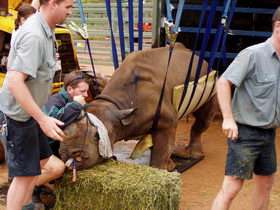First step to test tube rhinos

Scientists from the Leibniz-Institute for Zoo and Wildlife Research (IZW) in Berlin, Germany, together with veterinarians from Australia, have performed a world first by harvesting egg cells from a black rhino for the purpose of in-vitro fertilisation (IVF). The collected ova were matured in a test tube and were successfully fertilised with rhino sperm but they did not continue to grow into embryos. Nevertheless, the result is a major breakthrough.
IZW-veterinarian Robert Hermes says that “nobody succeeded so far in gaining living egg cells from a rhino”. The promising result was achieved at the Western Plains Zoo in Dubbo, Australia. This success now opens the door to in-vitro-fertilisation. “For some rhino subspecies, IVF is the only possibility of avoiding extinction and maintaining genetic diversity”, says Hermes. He adds: “Our method reliably yields many egg cells. The next step will be experiments in the lab to obtain embryos.” Such embryos could be implanted into female rhinos. If the rhino from which the ova were extracted is infertile, a surrogate mother could carry the rhino baby to term.
Key to the success is a new approach to access rhino ovaries. The standard method with farm animals is to punctuate through the cervical wall with a hollow needle in order to reach the ovaries. However, the complicated anatomy of rhinos makes such a simple procedure impossible. Thus, the IZW scientists headed by Thomas Hildebrandt invented a new tool, manufactured by the German company Schnorrenberg (Berlin), a specialist manufacturer of surgical tools. The new hollow needle is more than one metre long, fastened to an ultrasonic head and inserted through the rectum.
Ultrasonic investigations are routine for the Berlin experts Hildebrand, Hermes and Frank Göritz. “Our hollow needle is specially designed so that it can be viewed on the ultrasonic screen“, says Hermes. “As soon as we see the ovaries on our screen, we punctuate the intestine, push the needle towards the ovaries and suck in the egg cells.”
Is there a great risk for the animals? “No”, says Hermes. “We keep the risk of infection small by carefully preparing surgery.” Besides, past methods are rather riskier for the animals because they require lengthy periods of anaesthesia.
Supported by the veterinary surgeons Benn Bryant and Tim Portas from the Western Plains Zoo, the Berlin team took egg cells from a black rhino called “Muzi”. The animal had become infertile. Thomas Hildebrandt from the IZW says: “Our method can be applied to all rhino species and subspecies.” That is particularly interesting for those rhino cows that can no longer bear calves. If embryos were produced by IVF, surrogate mothers could deliver them. “Using IVF, we could increase the genetic diversity of rhino populations as well as help preserve the acutely threatened northern white rhino”, says Hermes.
Source: Forschungsverbund Berlin e.V.



















